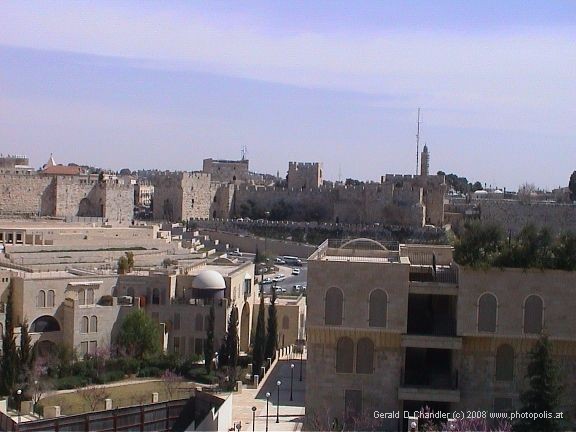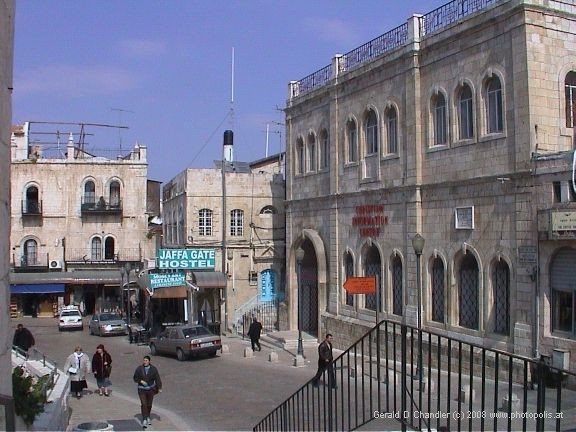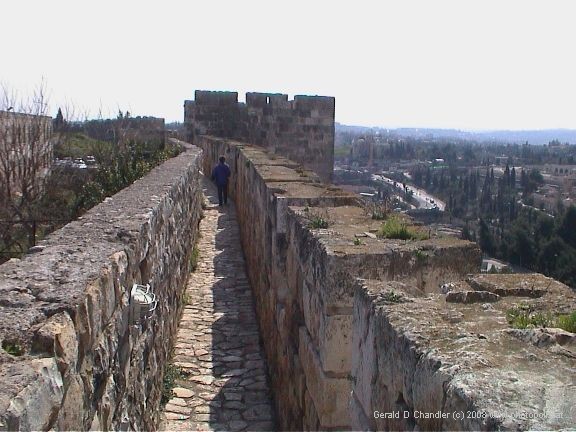Home | Front Page | Blog | Index | New | Contact | Site Map
Lincoln Apartment
Haas Promenade
Birthday Adventure
Galilee - Golan
North Med Coast
Empty Jerusalem
University Visits
Ein Karem
Foto Show
Public Forums
Are We Brave?
Refugee Camps

Egypt
Israel
Turkey
Bulgaria
Romania
Ukraine
Poland
Prague
Britain
USA 2002
Travel Map
About 11 a.m., following an especially lazy morning, we go to the old city, following a route now half familiar that takes us, as straight as possible, along Lincoln street past the YMCA and Paul Emile Botta streets toward the Jaffa gate, intending to tour the old city walls. The route, even with its wiggles and waggles, is almost due northeast. The YMCA (which Israelis pronounce "Yimka") with its imposing tower always impresses us, much more than the historic and rich King David Hotel, across the street which is no more than a sqare box with windows. On Botta street we pass the French Consulate, flag waving; the street is named after the French Diplomat who directed excavations that unearthed palaces built by the Assyrian king Sargon II (722-705 BC).
Now we cross the former Green line and enter what was once Jordanian territory. Just before we get to the Jaffa Gate, we cross an old/new park lying in the upper reaches of the Tyropolean Valley. It's old because its been there a long time; new because it has been redesigned by a landscape architect and it's nice, except, like in China, it has not been kept up. We imagine that the donors (mostly American, but also European and South American according to the placards) of such things are not asked for an endowment. Rather than planning ahead, it seems to be a matter of letting the future take care of itself.

Jewish Quarter toward Western Wall |
We don’t like the “new” Jaffa gate. The quiet road that used to pass beside it has been transformed into a busy four-lane highway that passes under a gate-level plaza that acts like a bridge for pedestrians from the gate area to a new shopping and residential area outside the gate. The bridge is there but work on the shopping/parking area is only half-finished and now abandoned, probably as usual because of the economic slowdown caused by the intifada, Sept 11, the US recession, and the resulting loss of tourists. What will be a row of shops now stands empty; what might one day be a busy "souk" street has a thin layer of dust with broken glass scattered here and there.
We head straight through the gate and see the “Tourist Information (and Change)” sign. It's obvious on which they make their money. Inside we ask the lady about monthly bus passes. She doesn’t know and suggested that we ask a bus driver. She readily accepted our explanation that bus drivers intimidated us with their sense of rush and our lack of Hebrew and she therefore made a phone call for us. Passes are monthly, from the first to the last day; cost NIS 188 or so, and give unlimited rides. If you make 20 round trips, each will cost NIS 9.4 while individual tickets would be 2 x 4.9 or NIS 9.8, so we conclude we should get tickets. Our second month we’ll make longer trips — go to the end of the line and walk about there. For the next two weeks we'll remain pedestrians.
Our next stop is the post office. The tourist information office lady told us where it is and we head directly there, just along and across the street, and directly opposite the entrance to the Citadel of David, where there is a sound and light show. How funny memory is — we went there in 1985 yet nothing seems the same. While the building is ancient, it may as well be entirely new, since the approach and ramparts and moat match nothing in our memory.
On the way to the post office — it is only a short way, but not short enough — we are accosted by a shopkeeper, or more likely, a representative of a shopkeeper, of somebody with tourists goods. He wants us to go down the short street past the post office and “just look” at his shop. "No, we are going to the post office." But he says that times were terrible and wouldn’t we come buy something? "No." "Well, then, how about some charity?" No. We explain that we encounter people nearly as demanding as he wherever we walk. We can’t buy from or give to all of them.
The recent tourist slowdown has of course turned good times (if that is what they were) into hard(er) times but there is really nothing new in this behavior. Fodor’s 1980 guide to Israel, speaking of a souk in Akko — where we had been just two days eariler and which was fresh in our minds as rivaling Jerusalem for color —, says “When you’ve finally made your getaway [from one shop] laden with your purchases, there’s a small boy waiting outside to tug your coat-tails and insist that you come with him because he has something important to show you. You wonder if he’s merely herding you to his uncle’s shop inside the walls, where there are souks, but once again your resistance is overcome, you’re charmed by so much self-assurance in one so young, and besides, why shouldn’t a sucker also be reborn every minute?”
We don’t go with our implorer and do go into the post office and do mail our three post cards. Ten minutes later we emerge shaking our heads at Israeli standards of service and politeness. We waited and waited to be served; two people were behind the counters doing something, but not serving customers. Eventually another man came in cut in front of us and got his service immediately. When we complained we were told that he had been called to the post office. We never learned why ready and present customers should be ignorned. We really shouldn’t complain about "Israeli service and politeness" because the clerks and two of the other three customers seemed to be Arabs. And maybe we shouldn't complain because we probably didn't understand the situation. As we emerged our imploring shopkeeper was there and asked in English, “Is it my turn now? Come to my shop.” But it wasn’t his turn.
In doing our planing we had originally thought we’d eat lunch today on Souk Khan az-Zeit, a narrow alley that leads from and to the Damascus gate and is often referred to as the main street of the old city, although it is far too narrow to be called a street. When we had walked down it the street seemed too exotic to not eat there at least once. But today it was too bright and sunny to want to be in one of the hole-in-the-wall restaurants that had intrigued us so on Saturday.

Old City just inside Jaffa Gate |
While on the bench a man came up and said, “You wanted a newspaper? Follow me.” At the sandwich stand we’d asked for English papers and gotten the answer that the shop next door didn’t carry them, nor did any nearby shop . This man had heard us and now offered to help get a paper. Gerry followed, saying “No shopping” and the man agreed. About ten shops down David Street, the lane heading to the bowels of the old city, the east-west “main street”, there was a shop and Gerry got not only the Jerusalem Post (with the Sunday New York Times ‘News of the Week in Review’) but Al-Ahram Weekly (an Egyptian English-language paper), each for NIS 6. At $1.30 per paper that seems expensive, but we do it. After Gerry had the papers in hand, the man who lead him said, “Now can you stop at my shop.” As Abraham Lincoln said, or should have said, you can’t please all of the people all of the time, so the answer was ‘no’.
A few weeks later we read an article about another street, that of the first part of the Via Dolorosa. Like David Street and Khan az-Zeit, it is lined with shops. Three and four years ago, according to the article, business was so good that some shop owners doubled the size of their shops. Many moved from relatively cramped living quarters above the shop out into new "villas" in Ramallah and similar Arab sections. Since the start of Intifada II business has dropped off; now it is so low that people are living off of savings. Some of the shop owners have moved back above the shop -- partly to save money and partly to minimize the effects of the roadblocks that can mean long travel hours or even failure to reach home or get to work.
Sandwich in hand we went to find the entry point for climbing and touring the wall. We had wanted to walk clockwise from the Jaffa gate via the Damascus Gate to the St Steven’s or Lions’ Gate, but upon our arrival at the Jaffa gate had found that the "north and then east" direction was closed. We could instead, said the sign at the closed ticket booth, go from the Jaffa Gate via the Zion Gate to the Dung Gate, the "south and east" route. Now, as instructed at the Citadel ticket office, we exited through the Jaffa Gate and walked left and left, looking for the entry. As we approached it we passed two men sitting and talking and one got up and accompanied us. He was the ticket salesman/taker. There was no business and he too was out in the sun rather than couped up in his cubicle.

Looking west toward King David Hotel and new City |
Ticket bought, we climbed some iron stairs and then a spiral staircase, also in iron. As we emerged on the parapet we immediately thought, “We got our money’s worth”. Right from the beginning there is a great view of the new city, particularly the Tyropolean Valley park we had so recently crossed, the King David Hotel, the YMCA tower peeking over it, the new Moshe Safid designed complex that houses the Hebrew Union College, and points beyond. "Our neighborhood," we thought possessively.
Looking the other way, inwards to the old city, we found that we were above the police compound. Apparently it has been there a long time, even if not 3500 years. It was used by the Turkish authorities (and probably built by them), by the British in their time, by the Jordanians when they had the old city, and now by the Israelis. Just a half an hour earlier, when we had emerged from the post office we had made a detour past the entry to the police station and past its rear in our search for the way onto the wall. Now we could look down and what did we see? To our suprise, a small courtyard with a loose dirt center where there were two horses. On the south side there were another two horses. One was being washed with a hose by a policeman. The horse seemed to know the routine and turned about this way and that as needed, saving the man from walking around the horse. We were a bit remote, but it did seem as if the horse squinted when the water went onto his head. Jan's father might have seen just such a scene during World War II when he was posted here.

Atop city wall south of Jaffa Gate |
We were, perhaps it's okay to say, “of course”, hungry. So we continued down the wall looking for a place to eat, stopping often to read the signs and explanations and enjoying the views which always changed a bit. Although its not organized for picnics — the normal crowds wouldn't permit it -- we did find a place to eat. We sat down on some steps on a tower in a bend in the wall to enjoy our Mediterrean sandwiches, to enjoy the sun (unusually warm for the season), and and to enjoy our recently bought papers. A few hours here would be fine. There was nothing more pressing than to enjoy. There was nobody about. When we bought the tickets there had been no line and now nobody came to disturb our meal. We had the place to ourselves.
After we were well through the papers, but before we were truly finished with them, and well before we would have welcomed an interruption, we had one. Another wall-tourist caught up to us and started a conversation. He seemed pretty knowledgable and started to offer us advice about things to see. Our suspicions started to form and before long they were confirmed. They certainly took longer to crystallize because he was an American; as we learned, from Boston and now resident in Jerusalem. If he had been Arab or Israeli we would have immediately guessed what was up: our conversationalist is a guide. Or, perhaps it is more precise to say he was a guide — was because there were so few tourists about. In an indirect way we turned down the services that were never directly offered. He went on and we went back to the papers and the sun and — decadence??

"Welcome to Jewish Quarter" |
Even we could not stay there forever. We left having been disturbed only once more, by three western tourists who quickly made their way around us on the stairs.We carefully examined all there was to see from the Ottoman wall, descended and made a stop at the Kotel (the Western Wall), and then ascended to the Jewish Quarter (or the Upper City as it was called in the time of the first Temple). We left by the Zion gate over which we had passed and walked home, passing our friends, the King David Hotel, and Imca..